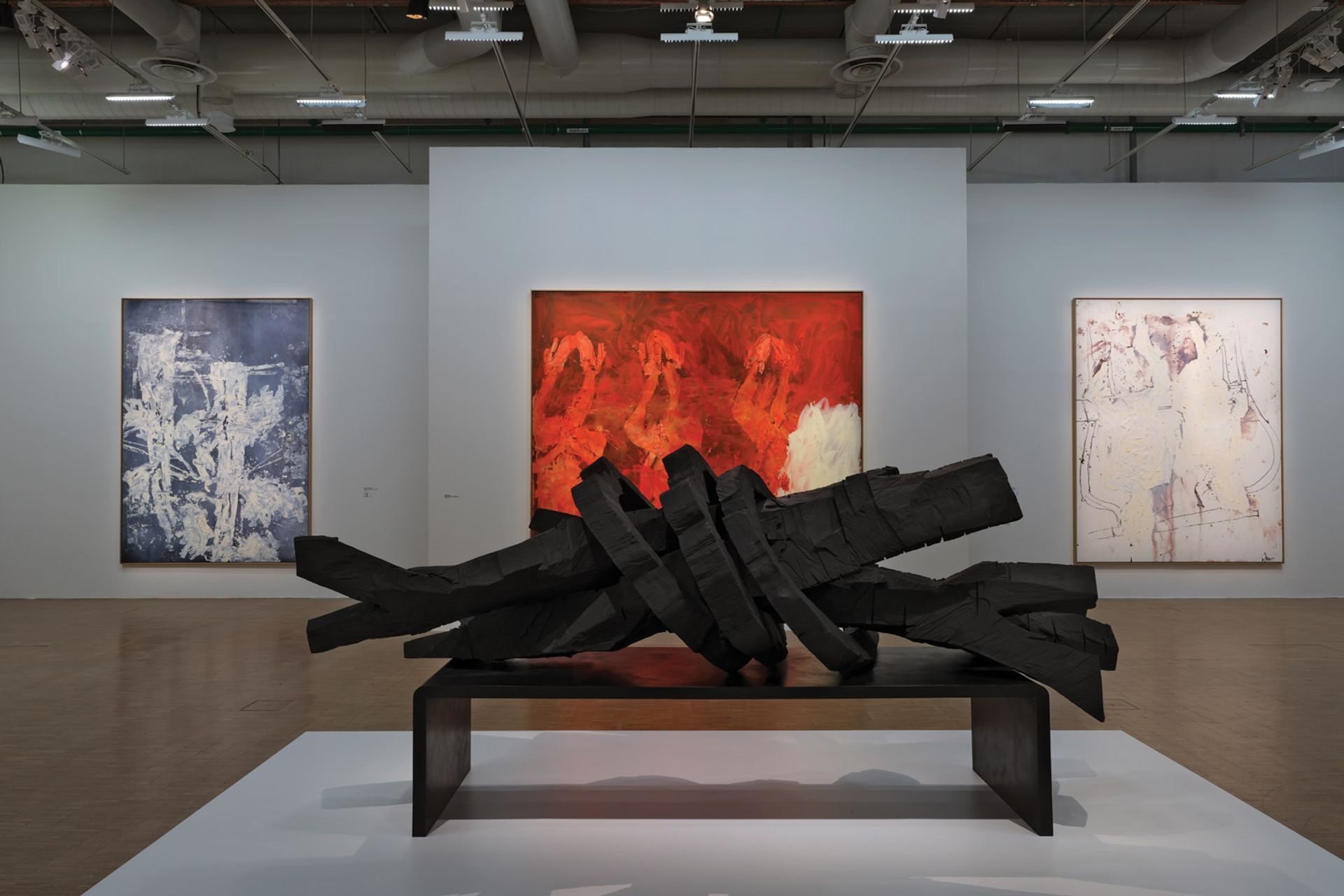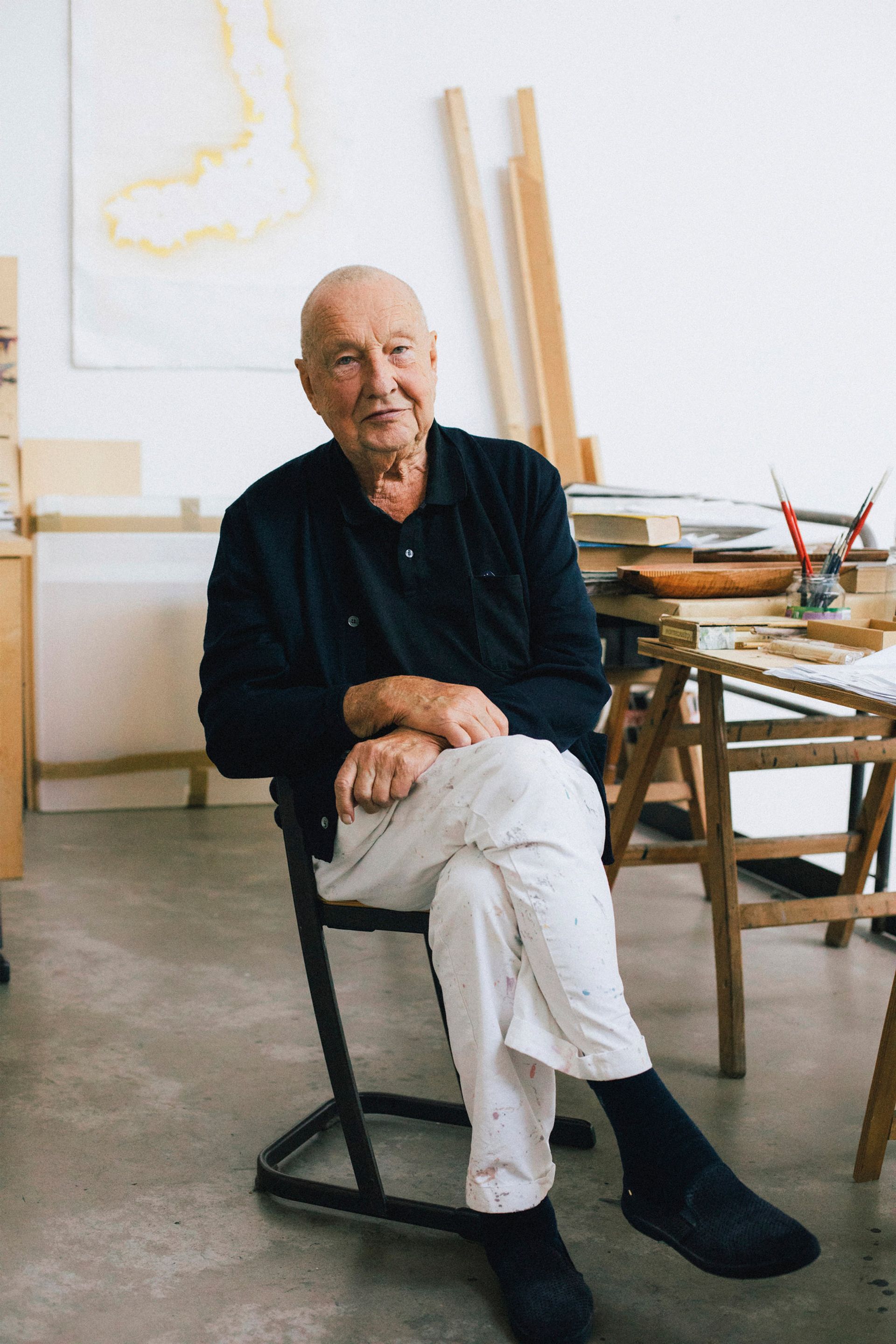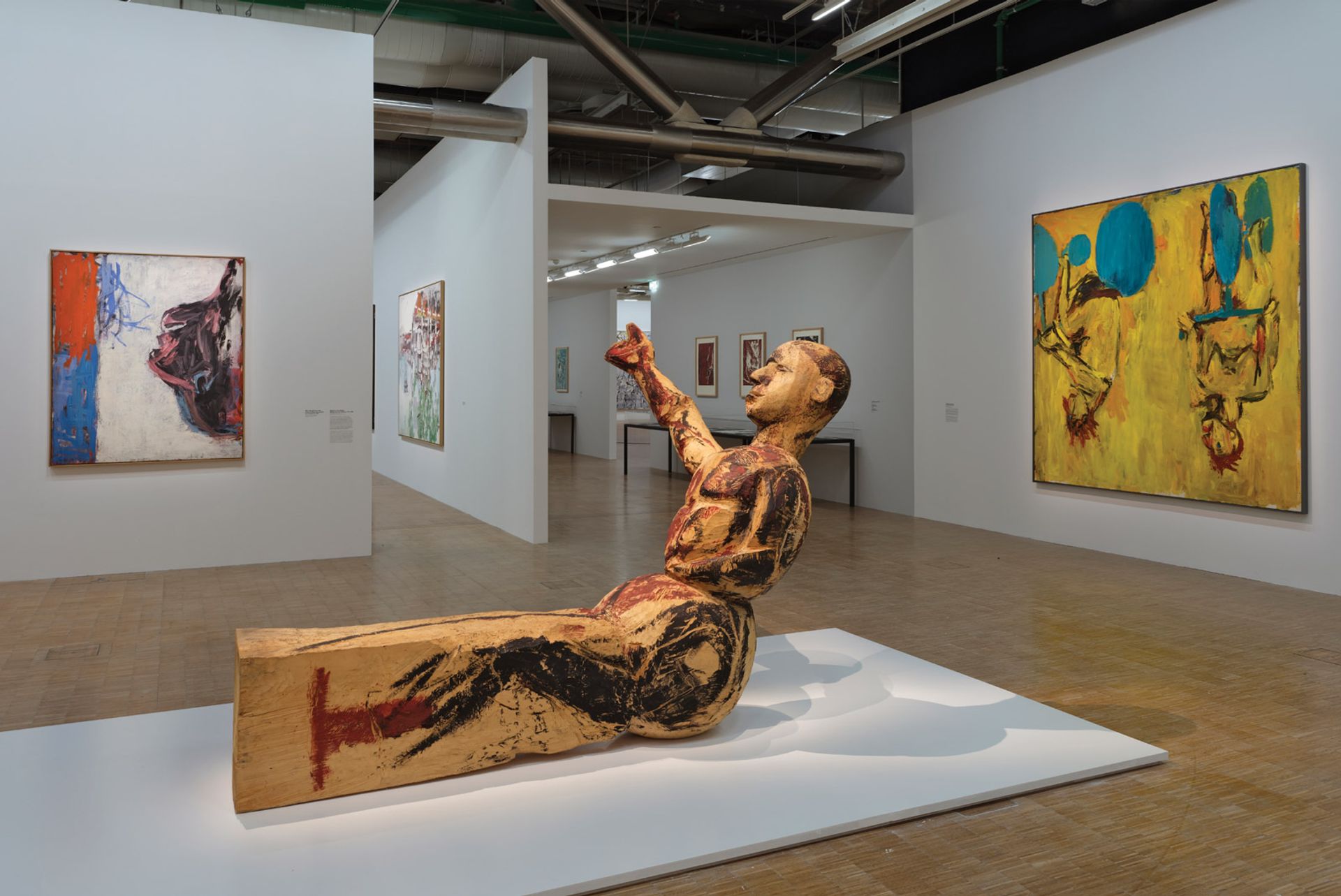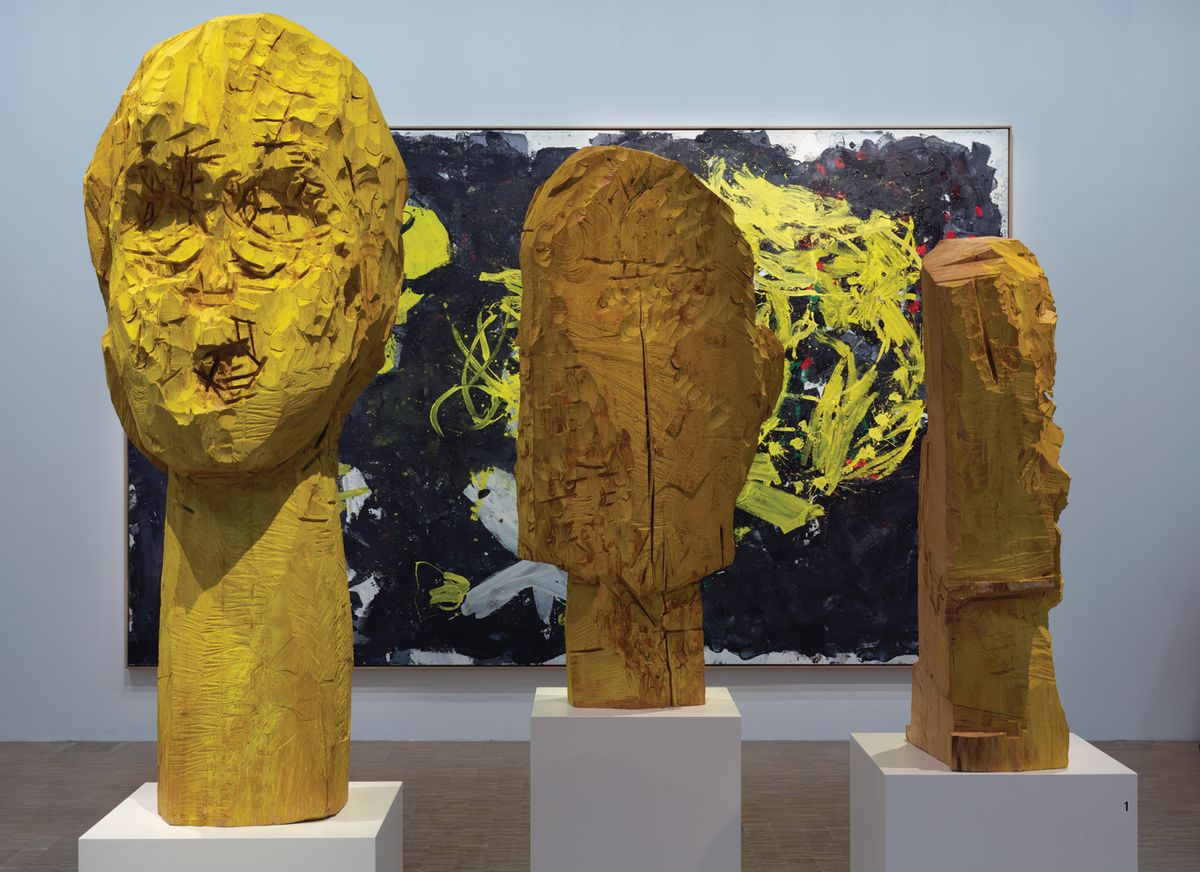In an interview in the catalogue for this huge retrospective, Georg Baselitz ponders what kind of artist he is—he’s anything but serious, he’s an inveterate experimenter, he says. “In fact,” he declares, “I am a monster.” It’s classic Baselitz. One of the difficulties in seeing his work lies in the heroic mythologies that form an armour around it. A chance to look at Baselitz afresh, at a time when painting is abundant and thrillingly diverse, is welcome.
Baselitz’s early biography is crucial to the heroic legend. He was born Hans-Georg Kern in 1938 and grew up in Deutschbaselitz, a village in Saxony, eastern Germany. His father, a teacher, was a committed Nazi and the young Hans-Georg witnessed the ruins of Dresden up close, a week after the Allied bombing of the city. Famously, he once said he grew up amid “a destroyed order, a destroyed landscape, a destroyed people, a destroyed society”. At art school in East Berlin from 1956, he immediately rejected the doctrine of the teachers. Baselitz says that little Modern art from Western Europe crept through to the German Democratic Republic, but he did learn about Picasso enough to incorporate his language into his early experiments. He was expelled for doing so and went to West Berlin in 1958, three years before the wall was built, and adopted the name of his village, Baselitz. He encountered the Abstract Expressionists—he particularly liked Pollock, De Kooning and Guston—but gained little satisfaction from the European abstraction that had become dominant. Trips to Paris and Amsterdam were also hugely formative: he encountered Gericault and Soutine, Dubuffet and Michaux. This was the grounding for what followed.

The final room of the exhibition is a return to form and features paintings and a sculpture Winterschlaf (hibernation, 2014) reflecting on the ageing body Bertrand Prévost; © Centre Pompidou
From the start, Baselitz knew uncompromisingly what he wanted—or, perhaps more importantly, what he didn’t. Rather than ripping up historic culture, as movements like Dada had, he wanted to dwell within the great art of the past, of which he’s become a distinguished collector, but to deconstruct it and create something new.
The curators wisely summarise the wilderness years, where Baselitz loses his thread
In his early 20s, he wrote two Pandemonium Manifestos with Eugen Schönebeck, and they appear in the exhibition, dotted with Baselitz’s intense ink drawings. Informed by the transgressive absurdism of Antonin Artaud and Samuel Beckett, they were Baselitz’s response to the cultural ruins of post-war Germany. The painting G. Antonin, a seething mass of paint as flesh, with vast erect penises, is among the coarse, abject works that make for a dramatic opening to the show. It evokes the first lines of the Pandemonium manifesto: “Poets lay in the gutter, their bodies in the morass. The whole nation’s spittle, floating on their soup.”
Baselitz’s brutal early paintings of feet are superb. Nods to Soutine’s meat and Gericault’s studies of severed limbs for the Raft of the Medusa are clear, but it’s impossible not to compare them to Guston’s feet, painted several years later. Baselitz had already seen Guston’s abstracts and the American painter’s fleshy language was evident even before his return to figuration in 1969. Is Guston somehow present in Baselitz’s marks here? Whatever, it was the Abstract Expressionists’ physicality, rather than their works’ spiritual and intellectual grounding, that attracted the young Baselitz.

Georg Baselitz in his studio, 2021. Photo: Christoph Schaller
The paintings that are the most infamous product of the Pandemonium Manifesto period, Die große Nacht im Eimer (the big night down the drain, 1962-63) and Der nackte Mann (the naked man, 1962), prompted a court case for indecency when shown at the Werner and Katz gallery in Kurfürstendamm in 1963. They remain startling today. Again, erections emerge from abject bodies: Die Große Nacht im Eimer, with a figure in shorts, his penis emerging from his fly, is partly based on a story of the Irish poet Brendan Behan getting his cock out during a reading, but has been seen as a self-portrait. In Der nackte Mann, it’s as if the penis rises from putrid flesh.
Realised in the crudest painterly language, these pictures are ribald and sardonic, of course, but something in them seems to disappear in much of Baselitz’s later work: a vulnerability within the absurdism. Despite their motifs, these aren’t macho images; they’re anti-heroic and evocative of human impotence in the face of overwhelming social conditions.
Following the scandal, Baselitz went to Florence in 1965 and, from here, his obsession with Italian Mannerism enters his work: he wants the contortions and distortions of that movement but to ally them to naive rawness. And he paints some of his best canvases. The series has come to be known as Helden (heroes) but it is far from heroic in any conventional sense. S-Bild (1965) is a self-portrait with an arm that looks necrotic, ribs like lacerated meat across Baselitz’s torso, and a vastly swollen neck. The manifesto painting for this period, Die Großen Freunde (the great friends, 1965), sees two figures standing mutually isolated against an apocalyptic scene—the “destroyed landscape” Baselitz described—with a limp flag at their feet, symbolic of his divided homeland.

An installation view of Baselitz—The Retrospective at the Centre Pompidou, Paris © CENTRE POMPIDOU / Bertrand Prévost
The next step from exaggerated bodies was fragmentation and, ultimately, inversion. Baselitz’s famous rupture, the shift to the upside-down motif from 1969, is presented almost as inevitable. First, you see how, living in the German countryside, he made the Fracture pictures. These are informed, among much else, by the Surrealist parlour game, exquisite corpse. The body is painfully absorbed into an arborial landscape, first tilted on its side and eventually upside down. The earliest inverted images, made from photographs, testify to the freedom Baselitz says he gained—they’re playful, with diverse motifs and styles, perhaps best exemplified by Fingermalerei—Adler (finger painting—eagle, 1972).
The succeeding galleries then show how Baselitz honed the upside-down paintings, dialling up the abstraction and becoming more reductive in his approach to the figure. Now living in a castle in Lower Saxony, Baselitz made the work with which he gained his fame amid the neo-Expressionist boom of the early 1980s. The curators present these sequences of paintings beautifully, from the distorted nudes of the mid-1970s featuring Baselitz and his wife, through the Mann im Bett (man in bed, 1982) series made for the Zeitgeist show in Berlin in 1982, responding to the expressionist poems of Georg Trakl, to the works of the same year drawing on Edvard Munch’s Self-Portrait in Hell (1903). But, for me, a certain numbness emerges in response to paintings that should, surely, move us. One can see the pictorial logic in Baselitz’s progression—it’s an absorbing journey, up to a point—but it’s as if the plug has been pulled on the electric charge of the earlier work. The paint is blunt, any subtlety has gone. Where before he offers a fresh take on Mannerism, Baselitz now becomes mannered.
His sculptures, which provoked a storm in the German Pavilion at the 1980 Venice Biennale, owing to an apparent Nazi salute in Modell für eine Skulptur (1979-80), betray a superficial understanding of the African sculptures he collects, where his earlier paintings had grappled productively with their sources. The curators wisely summarise the wilderness years of the 1990s and 2000s, where Baselitz loses his thread, remixes his own work and generally treads water, in a couple of rooms.
Only in the final space does he return to form. In a sequence of figure paintings made with a reduced palette, he reflects on the ageing body—his own and that of his beloved wife Elke. One responds in part to a stay she had in hospital, unmistakingly evoking an x-ray. These are stark yet tender paintings, with a newfound poetry, and paint as alive as in the earlier series.
This is in many ways a perfectly judged survey of an important painter of the last 60 years. But how important? Other artists ultimately propel their forebears into the future and in my many conversations with painters I can’t recall one who has mentioned Baselitz as an influence. He is a singular figure—a monstrous presence, indeed—but not guaranteed lasting significance.
Baselitz—The Retrospective, Centre Pompidou, Paris, until 7 March 2022
Curators // Bernard Blistène, former director, and Pamela Sticht, curator, Musée National d’Art Moderne, Centre Pompidou
• Ben Luke is the Review editor and podcast host at The Art Newspaper


